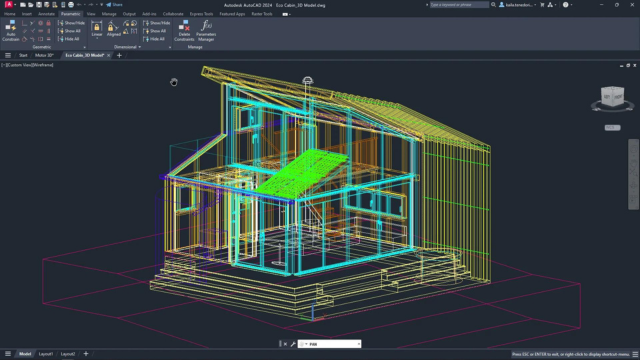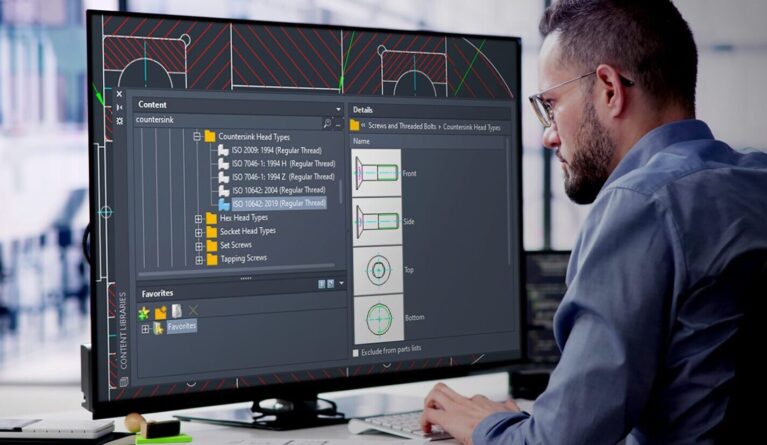At the forefront of CAD tools stands AutoCAD, a software known for its versatility and robust capabilities. Its application spans vast and diverse fields, from architectural marvels to product innovations. But what makes AutoCAD the go-to choice for professionals and enthusiasts alike? In the following pages, we embark on a comprehensive AutoCAD review, dissecting AutoCAD’s features, pros, and cons, pricing models, and its worthiness.
Keep reading and check them out!
Overview of AutoCAD: What Is AutoCAD Used for?

Before we dive into the AutoCAD review, let’s first address the question: What is AutoCAD? What is it used for? AutoCAD is a versatile and robust computer-aided design software, developed and marketed by Autodesk, Inc., and available since 1982. It offers a comprehensive set of tools for creating, editing, and documenting 2D and 3D designs, which enable architects, engineers, and designers to produce precise and detailed drawings, schematics, and models.
AutoCAD’s fundamental features include drawing and editing tools, layer management, dimensioning, and annotation. It has revolutionized the way we design, engineer, and create in various industries. Now, this software is extensively utilized in fields such as architecture, mechanical engineering, civil engineering, interior design, and more, playing a pivotal role in designing everything from buildings and infrastructure to mechanical parts and electronic circuits. With AutoCAD, professionals can streamline the design process, enhance accuracy, and improve collaboration.
AutoCAD Review: Pros and Cons
Given AutoCAD’s esteemed reputation within various industries, it’s vital to examine both its pros and cons. Compared to many other CAD software, AutoCAD is known for its exceptional professionalism, allowing users to draw as though using pen and paper. Moreover, its 3D capabilities enable the transformation of imaginative concepts into realistic renderings. However, it’s important to acknowledge that AutoCAD is not without its drawbacks. Only through a comprehensive understanding of both its strengths and weaknesses can you make an objective assessment of whether this software aligns with your specific needs.

Pros:
- Comprehensive toolset for design and drafting.
- Precision in 2D and 3D modeling.
- Save time and improve design efficiency.
- High customization options.
- It is easy to upload the designed data and share them.
- Cross-platform compatibility.
- Integration with third-party applications.
Cons:
- Complexity and overwhelming.
- Steeper learning curve.
- High price tags for individual users or small businesses with limited budgets.
- Resource-intensive, causing slower performance on older systems.
AutoCAD Review: Great Features of AutoCAD
AutoCAD is celebrated for its exceptional set of features that cater to the diverse needs of design professionals. Now, let’s delve into these features individually to gain a comprehensive understanding of what makes AutoCAD a powerhouse in the world of CAD.
Sufficient Toolsets
AutoCAD offers a comprehensive suite of tools designed to facilitate the precise creation, editing, and management of your drawings. It grants you access to extensive libraries featuring over 750,000 symbols, parts, and detail components Beyond fundamental drawing tools like lines, circles, rectangles, and polylines, what truly stands out in AutoCAD are its specific toolsets tailored to various industries. These include architecture, mechanical design, electrical, and plan 3D, among others. With those toolsets, you can find precisely the tools that align with your specific industry requirements.
For instance, in the architecture toolset, you’ll discover an impressive collection of over 8,800 architectural components, including multilevel blocks. It can swiftly generate a range of architectural elements such as floor plans, elevations, sections, and ceiling grids, significantly reducing the time and effort required for your design projects.

2D Drafting and 3D Modeling
AutoCAD is a comprehensive software package that seamlessly integrates both 2D and 3D functionality. In its 2D mode, users can utilize its tools, such as lines, arcs, and circles, to create detailed 2D drawings, including floor plans, layouts, and orthographic views. What’s more, AutoCAD excels in dimensioning and annotation, making it easy to add measurements, text, and labels to drawings.
Switching to the 3D mode, there are several types of 3D modeling available in AutoCAD, namely 3D wireframe, 3D solid, 3D surface, and 3D mesh. With these options, you can craft intricate 3D models, and designs, and even render lifelike visualizations of your projects. The software offers a range of 3D modeling tools, including extrude, revolve, loft, and sweep. Plus, you can manipulate objects in 3D space, and apply materials and textures to your designs.
One of AutoCAD’s key strengths is its seamless transition between 2D and 3D modes, allowing designers to effortlessly move from flat 2D drawings to richly detailed 3D models. This flexibility is invaluable, making AutoCAD a preferred choice for professionals in various industries where the ability to work in both 2D and 3D is essential.
Customization
Customization within AutoCAD, a key feature across all its products, including AutoCAD LT, is a fundamental aspect of the software’s adaptability. It empowers users to craft a tailored workspace that not only enhances productivity but also enables them to work more efficiently on a diverse array of design projects.
AutoCAD provides a wide range of customization options to suit individual needs. You can make general customizations, such as altering the default directory structure for the program and support files to better align with your specific requirements. Furthermore, AutoCAD allows the creation of custom user commands, enabling users to define their commands or shortcuts for frequently used actions.
In terms of the software’s interface, users have the freedom to personalize it to match their specific workflow. This includes the rearrangement of tool palettes, the creation of custom toolbars, and the organization of panels to ensure that frequently used tools are easily accessible.
For those with programming skills, AutoCAD offers the capability to create custom routines and automate repetitive tasks using AutoLISP. This feature serves as a valuable tool for streamlining complex operations, reducing errors, and enhancing efficiency.

Smart Objects
AutoCAD’s utilization of smart objects, including dynamic blocks and dynamic attributes, significantly enhances work efficiency in the design process.
Dynamic blocks in AutoCAD are customizable, reusable components that can adapt to various design scenarios. These blocks include parameters and actions that allow them to change shape, size, or appearance based on user-defined input. So, you can insert a dynamic block to replace multiple static blocks, reducing repetition and increasing productivity.
Dynamic attributes are data-driven properties attached to objects in AutoCAD. They are typically used to add intelligence and flexibility to blocks in your AutoCAD drawings. Dynamic attributes can be associated with parameters that control the attributes’ values. Parameters can be linked to geometric elements or can be defined independently. When you change the value of a parameter, it can affect one or more dynamic attributes within the block. Also, they facilitate the inclusion of data in drawings, such as part numbers or project-specific information. This data can be maintained consistently throughout the project. When design changes occur, dynamic attributes adjust automatically, eliminating the need to manually update associated text or data.
How to Learn AutoCAD?
After subscribing to the software, it’s advisable to begin by understanding AutoCAD’s tools and the fundamentals of drafting. Autodesk’s official documentation provides comprehensive online resources, including user guides and tutorials. These resources serve as an excellent starting point.
Once you’ve gained some basic familiarity with the software, you can explore further learning options if you wish to advance your skills and become more proficient. YouTube offers a wealth of free step-by-step guidance on various AutoCAD topics. Additionally, various online learning platforms like Udemy, Coursera, and LinkedIn Learning offer AutoCAD courses catering to both beginners and advanced users.
Completing these courses will provide structured learning and a deeper understanding of AutoCAD. However, it’s crucial to supplement your learning with regular practice. Put your newfound knowledge into action by working on drawings and projects. Practical experience will reinforce your skills and boost your confidence.
Contact us for free and detailed advice:













